Home - Identify A Spider
- Hobo Spiders - Brown Recluse
- Q&A at the
Spider Forum - Order Traps

Frequently Asked Questions
Below are answers to the most frequently asked questions we have received. They are organized by category/subject. Please read through this list before submitting a question to the forum.
Geography - Are Spiders in my neighborhood?
Spider Identification - I saw/caugt a spider,
what is it?
Bites-Identification, Symptoms, and Treatment
Spider Control - Natural preditors and commercial products
Where do Hobo and Recluse Spiders live?
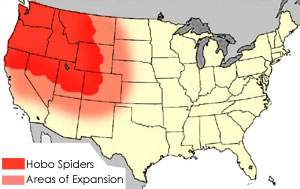 |
Hobo Spiders live in the Northern United States as well as Canada. They can be found anywhere in Washington, Oregon, Idaho, Montana, Wyoming, Utah, Colorado,and Southern British Columbia. We feel that it is likely that there are Hobos in Northern California. We have also received spider samples from the many parts of Mid-West and North Eastern USA which appear to be Hobo spiders. The Red areas of the maps show regions with Hobo Spiders.
|
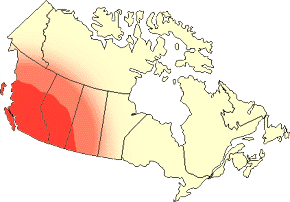 |
|
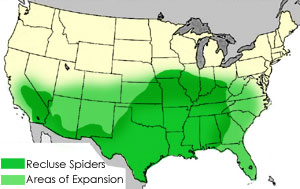 |
Brown Recluse Spiders live in the southern United States from California to Florida and up to Nebraska & Missouri and over to Virginia. The slashed lines on the map show regions with Brown Recluse Spiders. |
I saw/caught a Spider. How can I identify it?
First, visit the Identification Page to find a match. If you can't find your spider, send an email to info@hobospider.net and ask how to proceed. Let them know if you have digital pictures, live samples, or other resources.
What do Hobo and Brown Recluse Spiders look like?
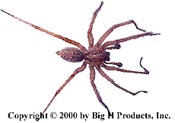 |
|
Male Hobo Spider |
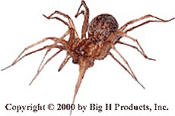 |
|
Female Hobo Spider |
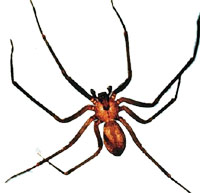 |
| Brown Recluse Spider |
Hobo Spiders are brown and measure roughly 12 to 18 mm in length. Their legs show no distinct rings and have short hairs. Their abdomens have several chevron shaped markings.
Males are distinctively different from females in that they have two large palps that look like boxing gloves. These palps are often mistaken for fangs or venom sacs, but they are in fact the male genitalia.
The females also have these palps, but the ends are not 'swollen' as they are on the males. Females tend to have a larger abdomen when compared to males.
The most recognized feature of the Brown Recluse spider is violin pattern on the cephalothorax or, in other words, the location on the top side of the spider near the head. Thus they have been nicknamed the Fiddleback Spider. This characteristic is common in adult brown recluses, but some young brown recluse spiders do not have any contrasting pigmentation in the violin region.
Recluse spiders also have abdomens devoid of any coloration pattern. Their legs lack thickened spines but are covered with fine hairs.
Unlike most U.S. spiders, the Brown Recluse spider has six eyes arranged in pairs called dyads. (Most U.S. spiders have eight eyes arranged in two rows of four.) One dyad is anterior, or toward the front, and the other two are lateral, or toward the sides of the cephalothorax (where the first legs of the spider attach to the body). All 13 species of U.S. recluses have this same eye pattern.
What do their webs look like?
 The
Hobo Spider creates a non-sticky (in spider standards) trip web that doesn't
permanently stick insects to the web. Instead, once the prey trips on
the web the hobo spider attacks the prey before it can get away. This
along with its poor eye site explains why they are noticeably more aggressive
to humans then other spiders. They have to attack to eat otherwise they
would die of starvation.
The
Hobo Spider creates a non-sticky (in spider standards) trip web that doesn't
permanently stick insects to the web. Instead, once the prey trips on
the web the hobo spider attacks the prey before it can get away. This
along with its poor eye site explains why they are noticeably more aggressive
to humans then other spiders. They have to attack to eat otherwise they
would die of starvation.
Their webs are funnel shaped and are often attached to an object in the yard--by the foundation--between planters, or anything that remains stationary near the ground level. It also makes webs under the siding of homes and attaching to plants or weeds.
Here is an example of a large hobo spider web--20% of actual size. Most webs are not as obvious and large, these are pictures taken between 2 planters for new trees.
Brown Recluse Spiders do not build webs.
What does a Hobo or Brown Recluse Spider Bite look like?
 To the
left is a picture of a Hobo Spider bite. About 50% of Hobo Spider bites
are 'dry,' meaning that no venom is injected, and nothing happens to the
victim. Often times the victim does not even realize that he has been
bit.
To the
left is a picture of a Hobo Spider bite. About 50% of Hobo Spider bites
are 'dry,' meaning that no venom is injected, and nothing happens to the
victim. Often times the victim does not even realize that he has been
bit.
What will happen after I'm bit?
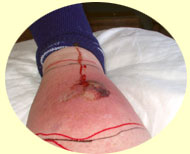 Typically,
when venom is injected, the victim will experience an immediate redness
which develops around the bite, then begins to disappear within a few
hours. Very often, for the first 24 hours, the bite appears to be no worse
than that of a mosquito; then it begins to blister in the center. Within
24 to 36 hours the blister breaks open leaving an open, oozing ulceration.
Typically,
when venom is injected, the victim will experience an immediate redness
which develops around the bite, then begins to disappear within a few
hours. Very often, for the first 24 hours, the bite appears to be no worse
than that of a mosquito; then it begins to blister in the center. Within
24 to 36 hours the blister breaks open leaving an open, oozing ulceration.
This ulceration 'scabs' over within three weeks from the initial bite, leaving a permanent scar. If the bite is delivered in fatty tissue, the lesion may be very deep and extensive and not heal for two or three years. Systematic reactions to Hobo Spider poisoning include severe headaches, nausea, vomiting, soreness, and flu-like symptoms.
What should I do if I get bit?
Consult a physician. In extreme cases where the bite was not taken care
of early, skin graft, amputation, and the possibility of bone marrow failure
may occur.
What are natural preditors of Hobo and Brown Recluse Spiders?
There are 3 major predator spider types that if found in homes seem to reduce the amount of Hobo spiders: the Steatoda spiders, Large jumping spiders, and the other harmless European House spiders.
Pets such as cats will feed on Hobo and Brown Recluse spiders after playing with them. The preying mantis will also eat Hobo spiders but due to its day time activity and the Hobo spiders night time activity optimum results are not achieved.
Other competitors or predators would include birds, cats, "cat face" spiders, wolf spiders, some crab spiders, several wasps, and other web weavers that may catch a hobo in its web and then feast. The reason for some of the effectiveness of these other insects is not because they are incredible hunters. Instead, it is because of competitive exclusion or in other words, there just isn't enough room or food for the hobo spider so it won't try to make a home.
How can I control Hobo and Brown Recluse Spiders?
Darwin Vest, the foremost expert on Hobo Spiders, stated that ". . . traps are far and away the most safe and effective measure that can be used for controlling hobo spiders indoors." And, in fact, traps have shown to be the most effective means available to control Hobo Spider populations.
In order to kill Hobo spiders with pesticides you usually have to hit the spider directly with large doses. The problem with non discriminate spraying is that you kill the good competitor and predator spiders and insects and thus make more room for the more mobile and hardy Hobo spider. This will often lead to a worse problem with Hobo spiders as one man witnessed in 1997 in his own home.
Find a Local Reseller Order Online Here!
Learn about Brown Recluse Spiders
or Hobo Spiders
Identify a Spider
Have your questions answered in our Forum.